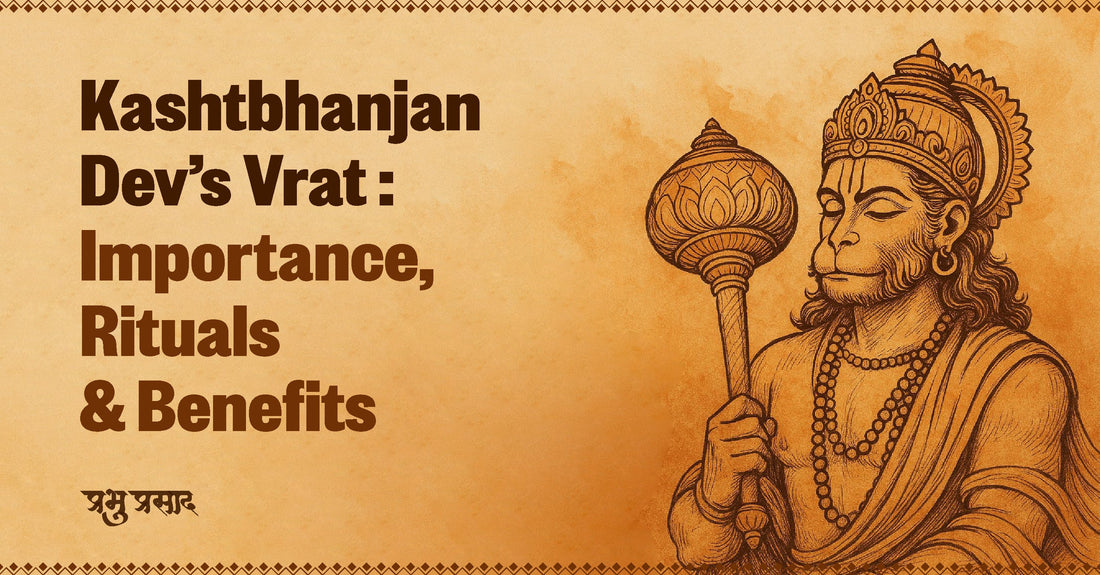
Kashtbhanjan Dev’s Vrat – Importance, Rituals & Benefits
Share
Introduction: Who is Kashtbhanjan Dev?
Kashtbhanjan Dev, also known as Kashtbhanjan Hanumanji, is one of the most revered forms of Lord Hanuman. The word “Kasht” means pain or trouble, and “Bhanjan” means destroyer. Hence, Kashtbhanjan Dev is believed to be the remover of all sorrows, troubles, and negative energies.
He is especially worshipped in Salangpur, Gujarat, at the world-famous Kashtbhanjan Hanuman Mandir, which attracts lakhs of devotees from across India and beyond. Among his many forms, this form is known for quick, miraculous blessings—especially when devotees observe the sacred Vrat (fast) with faith.
Why Do Devotees Observe Vrat for Kashtbhanjan Dev?
The Vrat of Kashtbhanjan Dev is not just a religious ritual—it is a spiritual discipline. It is observed by devotees who are facing:
-
Long-term health issues
-
Financial struggles
-
Family disputes
-
Evil eye or black magic
-
Court cases or legal issues
-
Mental stress and depression
By observing the Vrat with complete devotion, purity, and faith, devotees believe that Lord Hanuman himself intervenes and destroys all obstacles in their lives.
Days to Observe the Vrat
The most powerful days to observe Kashtbhanjan Dev’s Vrat are:
-
Tuesdays (Mangalvar) – Dedicated to Lord Hanuman
-
Saturdays (Shanivar) – Known for Shani Dosha relief through Hanuman worship
-
Full Moon (Purnima) – Considered auspicious for prayers
-
Hanuman Jayanti – A once-in-a-year major celebration
How to Observe the Vrat (Step-by-Step Rituals)
1. Sankalp (Resolution)
Start with a pure heart. Make a sankalp (vow) that you will observe the Vrat for a specific purpose or number of weeks (e.g., 11 Tuesdays or 21 Saturdays).
2. Cleanliness and Bath
Wake up early, take a bath, and wear clean (preferably red/orange) clothes. Maintain physical and mental purity.
3. Fasting (Upvaas)
You can observe Nirjala Upvaas (without food and water) or Phalahar Upvaas (fruits and milk). Avoid salt, grains, and spicy food.
4. Hanuman Chalisa Path
Chant the Hanuman Chalisa at least 7 or 11 times, along with Bajrang Baan, Sundarkand, or Hanuman Ashtak.
5. Visit Hanuman Temple
If possible, visit a Hanuman temple or Kashtbhanjan Mandir in Salangpur. Offer Sindoor, Chameli oil, coconut, ladoos, and red flowers.
6. Offer Prasad
Distribute prasad (sacred food) to others, especially children and the needy.
7. Avoid Negativity
During the Vrat, avoid anger, lies, meat, alcohol, and negative speech.
Kashtbhanjan Vrat Katha (Story Behind the Vrat)
Once upon a time, a poor woman was suffering from incurable illness and poverty. She had lost all hope. One day, a sage told her to observe 11 Tuesdays of Vrat dedicated to Kashtbhanjan Hanumanji.
She followed it sincerely, chanting the Hanuman Chalisa daily, feeding poor children, and visiting the temple with deep faith.
On the 11th Tuesday, her illness vanished, her home was filled with wealth and peace, and all her problems disappeared.
This story spread far and wide, making the Kashtbhanjan Vrat one of the most followed spiritual disciplines across Gujarat and India.
Spiritual and Practical Benefits of Kashtbhanjan Dev’s Vrat
-
Removes mental and physical distress
-
Cleanses bad karmas and past sins
-
Protects from evil energies and black magic
-
Improves family harmony and marital life
-
Helps in job, business, and studies
-
Strengthens willpower, courage, and confidence
-
Resolves court or legal issues
Many devotees share testimonials of sudden relief from long-pending problems after completing this Vrat.
Must-Do Mantras for Vrat
Here are some powerful mantras to chant during the Vrat:
1. Hanuman Gayatri Mantra:
"Om Anjaneyaya Vidmahe, Vayuputraya Dhimahi, Tanno Hanumat Prachodayat."
2. Kasht Nivaran Mantra:
"Kasht Haran Hanuman Raksha Karo, Dukh Daman Hanuman Kripa Karo!"
3. Hanuman Mool Mantra:
"Om Namo Hanumate Rudravataraaya Vishwa Roopaaya Vishwaaya Namah"
Kashtbhanjan Dev in Salangpur: The Epicenter of Faith
The Salangpur Hanuman Mandir is a miraculous place where thousands come every day seeking divine help. The temple is known for exorcisms, healing of psychological disorders, and fulfillment of vows made during the Vrat.
People tie coconuts or bangles on temple railings after their wishes are fulfilled, a tradition deeply rooted in gratitude.
How to End the Vrat (Udyapan)
After completing the number of Vrats you vowed for, perform Udyapan:
-
Visit Hanuman temple
-
Offer full thali of prasad (coconut, sweets, fruits)
-
Recite full Hanuman Chalisa and Sundarkand
-
Distribute food or donate to poor
-
Light a diya of ghee for Hanumanji
Devotion Beyond Rituals
While rituals are important, the real strength of the Vrat lies in:
-
Shraddha (faith)
-
Bhakti (devotion)
-
Niyam (discipline)
Kashtbhanjan Dev listens to the call of a pure heart, not just complex rituals. Even a single chant of “Jai Bajrangbali” with full surrender can transform your destiny.
Conclusion: Transform Your Life With Hanuman’s Grace
The Vrat of Kashtbhanjan Hanumanji is more than a tradition—it’s a path to hope, healing, and divine protection. If you are facing challenges, make a vow today. Let Hanumanji’s blessings guide you out of the darkness.
As countless devotees say:
"Jahan Kasht ho, wahan Kashtbhanjan aate hai!"
